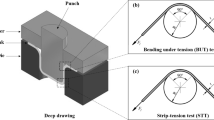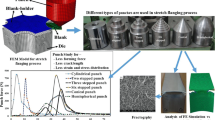Abstract
This investigation analyses the effect of friction which is influenced by the parameters including type of lubricant, surface roughness of the sheet, die geometry and punch velocity on springback and bend force of electrogalvanised steel sheet in air-bending process experimentally. It is observed that the decrease in friction increases the springback and reduces the bend force. This effect is evident in case of high-viscosity lubricant, low surface roughness, larger die radius and higher punch velocity.





Similar content being viewed by others
Abbreviations
- d p :
-
Punch travel, mm
- E :
-
Young’s modulus, GPa
- L s :
-
Length of the sheet, mm
- R a :
-
Surface roughness, μm
- R d :
-
Die radius, mm
- R p :
-
Punch radius, mm
- T :
-
Sheet thickness, mm
- t c :
-
Coating thickness, μm
- V p :
-
Punch velocity, mm/s
- W d :
-
Die opening, mm
- W s :
-
Width of the sheet, mm
- σ y :
-
Yield strength, MPa
- σ u :
-
Ultimate tensile strength, MPa
- θ i :
-
Bend angle (during loading), °
- θ f :
-
Bend angle (after unloading), °
- ∆θ:
-
Springback angle, °
References
De Vin LJ (2000) Curvature prediction in air bending of metal sheet. J Mater Process Technol 100:257–261
Farsi MA, Arezoo B (2011) Bending force and spring-back in V-die bending of perforated sheet- metal components. J Braz Soc Mech Sci Eng 23:45–51
Hamouda AMS, Abu Khadra F, Hamadan MM, Inhemed RM, Mehdi E (2004) Springback in V-bending : a finite element approach. Int J Mater Prod Technol 21(1–3):124–136
Han SS (1997) The influence of tool geometry on friction behavior in sheet metal forming. J Mater Process Technol 63:129–133
Jiang HM, Chen XP, Wu H, Li CH (2004) Forming characteristics and mechanical parameter sensitivity study on pre-phosphated electro-galvanized sheet steel. J Mater Process Technol 151:248–254
Kim JK, Thomson PF (1990) Friction and stress distribution in coated steel sheet during forming. J Mater Process Technol 21:29–42
Lee BH, Keum YT, Wagoner RH (2002) Modelling of the friction caused by lubrication and surface roughness in sheet metal forming. J Mater Process Technol 130–131:60–63
Liu X, Liewald M, Becker D (2009) Effects of rolling direction and lubricant on friction in sheet metal forming. J Tribol Trans ASME 131(042101):1–8
Lovell MR, Deng Z (2002) Characterization of interfacial friction in coated sheet steels: influence of stamping process parameters and wear mechanisms. Tribol Int 35:85–95
Matuszak A (2000) Factors influencing friction in steel sheet forming. J Mater Process Technol 106:250–253
Narayanasamy R, Padmanabhan P (2010) Influence of lubrication on springback in air bending process of interstitial free steel sheet. J Mater Eng Perform 19(2):246–251
Ragai L, Lazim D, Nemes JA (2005) Anisotropy and springback in draw bending of stainless steel 410: experimental and numerical study. J Mater Process Technol 166:116–127
Ramezani M, Mohd Ripin Z, Ahmad R (2010) Modelling of kinetic friction in V-bending of ultra-high-strength steel sheets. Int J Adv Manuf Technol 46(1–4):101–110
Saha PK, Wilson WRD (1994) Influence of plastic strain on friction in sheet metal forming. Wear 172:167–173
Schey JA, Dalton GM (1990) Lubrication mechanisms in the forming of galvanized steel sheet. J Mater Process Technol 24:365–374
Schey JA (1983) Tribology in metal working, friction, lubrication and wear. ASM International, New York
Schey JA (1996) Speed effects in drawbead simulation. J Mater Process Technol 57:146–154
Skarpelos P, Morris JW Jr (1997) The effect of surface morphology on friction during forming of electrogalvanized sheet steel. Wear 212:165–172
Wang W, Wagoner RH, Wang XJ (1996) Measurement of friction under sheet forming conditions. Metal Mater Trans A 27A:3971–3981
Author information
Authors and Affiliations
Corresponding author
Additional information
Technical Editor: Alexandre Abrão.
Rights and permissions
About this article
Cite this article
Srinivasan, R., Vasudevan, D. & Padmanabhan, P. Influence of friction parameters on springback and bend force in air bending of electrogalvanised steel sheet: an experimental study. J Braz. Soc. Mech. Sci. Eng. 36, 371–376 (2014). https://doi.org/10.1007/s40430-013-0097-8
Received:
Accepted:
Published:
Issue Date:
DOI: https://doi.org/10.1007/s40430-013-0097-8




